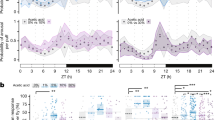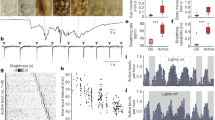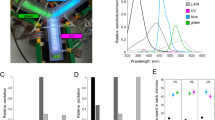Abstract
The discovery that various states of sleep, rest, wakefulness and arousal in man can be correlated with specific forms of the electroencephalogram1 has led to intensive studies of these states, mostly in mammals2–5. Today it is generally accepted that circadian sleep-wakefulness cycles occur in mammals and birds2,3,6. Behavioural observations on sleep in moths have also been published7; many other invertebrates demonstrate rest/activity cycles8. Circadian sensitivity fluctuations in both central9 and peripheral10–15 components of the visual system of various nocturnal arthropod species have been demonstrated. We now report that long-term, extracellular, single-unit recordings from optomotor interneurones in the optic lobes of forager honey bees reveal an oscillation in their sensitivity to moving visual stimuli16,17. The oscillation displays properties typical of a circadian rhythm6,18. The sensitivity of the neurones is higher during the subjective day than during the subjective night. The locomotor activity of individual, fixed walking forager bees shows a similar circadian oscillation and is also higher during the subjective day. Visual and mechanical stimuli can act directly on the interneurones and restore their sensitivity during times of reduced neuronal responsiveness. A comparison with results available for mammals makes it likely that the neuronal phenomena presented here are correlates of the bee's circadian sleep-wakefulness rhythm.
This is a preview of subscription content, access via your institution
Access options
Subscribe to this journal
Receive 51 print issues and online access
$199.00 per year
only $3.90 per issue
Buy this article
- Purchase on Springer Link
- Instant access to full article PDF
Prices may be subject to local taxes which are calculated during checkout
Similar content being viewed by others
References
Berger, H. Arch. Psychiat. Nervenkr. 87, 527–570 (1929).
Baust, W. (ed.) Ermüdung, Schlaf und Traum (Wissenschaftliche Verlagsgesellschaft mbH, Stuttgart, 1970).
Enright, J. T. The Timing of Sleep and Wakefulness (Springer, Berlin, 1980).
Borbély, A. A. & Neuhaus, H. U. J. comp. Physiol. 124, 1–14 (1978); 128, 37–46 (1978).
Mitler, M. M., Lund, R., Sokolove, P. G., Pittendrigh, C. S. & Dement, W. C. Brain Res. 131, 129–145 (1977).
Aschoff, J. (ed.) Handbook of Behavioral Neurobiology Vol. 4 (Plenum, New York, 1981).
Andersen, F. S. Opusc. Ent. 33, Pt 1–2, 15–24 (1968).
Brady, J. in Handbook of Behavioral Neurobiology Vol. 4 (ed. Aschoff, J.) 125–144 (Plenum, New York, 1981).
Aréchiga, H. & Wiersma, C. A. G. J. Neurobiol. 1, 71–85 (1969).
Aréchiga, H. & Huberman, A. Frontiers Horm. Res. 6, 16–34 (1980).
Barlow, R. B. Jr & Chamberlain, S. C. in The Effects of Constant Light on Visual Processes (eds Williams, T. P. & Baker, B. N.) 247–269 (Plenum, New York, 1980).
Fleissner, G. J. comp. Physiol. 91, 399–416 (1974).
Fleissner, G. & Fleissner, G. Comp. Biochem. Physiol. 61 A, 69–71 (1978).
Wada, S. & Schneider, G. Z. vergl. Physiol. 58, 395–397 (1968).
Yamashita, S. & Tateda, H. J. comp. Physiol. 143, 477–483 (1981).
Kaiser, W. Verh. Dtsch. Zool. Ges. 1979, 211 (1979).
Kaiser, W. in The Biology of Social Insects (eds Breed, M. D.f Michener, C. D. & Evans, H. E.) 352–355 (Westview, Boulder, 1982).
Brady, J. Biological Clocks (Edward Arnold, London, 1979).
DeVoe, R. D., Kaiser, W., Ohm, J. & Stone, L. S. J. comp. Physiol. 147, 155–170 (1982).
Kaiser, W. & Bishop, L. G. Z. vergl. Physiol. 67, 403–413 (1970).
Spangler, H. G. Ann. ent. Soc. Am. 65, 1073–1076 (1972).
Lindauer, M. Z. vergl. Physiol. 34, 299–345 (1952).
Rowell, C. H. F. J. exp. Biol. 55, 749–761 (1971).
Livingstone, M. S. & Hubel, D. H. Nature 291, 554–561 (1981).
Milde, J. thesis, Freie Univ. Berlin (1982).
Aréchiga, H., Huberman, A. & Naylor, E. Proc. R. Soc. B187, 299–313 (1974).
Autrum, H. in Handbook of Sensory Physiology Vol. 7, Pt 6C (ed. Autrum, H.) 1–91 (Springer, Berlin, 1981).
Swihart, S. L. Zoologica 48, 155–165 (1963).
Rowell, C. H. F. & Horn, G. J. exp. Biol. 49, 171–183 (1968).
Rowell, C. H. F. J. exp. Biol. 55, 727–747 (1971).
Rowell, C. H. F., O'Shea, M. & Williams, J. L. D. J. exp. Biol. 68, 157–185 (1977).
Author information
Authors and Affiliations
Rights and permissions
About this article
Cite this article
Kaiser, W., Steiner-Kaiser, J. Neuronal correlates of sleep, wakefulness and arousal in a diurnal insect. Nature 301, 707–709 (1983). https://doi.org/10.1038/301707a0
Received:
Accepted:
Issue Date:
DOI: https://doi.org/10.1038/301707a0
This article is cited by
-
A perspective on neuroethology: what the past teaches us about the future of neuroethology
Journal of Comparative Physiology A (2024)
-
Why study sleep in flatworms?
Journal of Comparative Physiology B (2023)
-
How India Changed My Ideas About Honey Bees
Journal of the Indian Institute of Science (2023)
-
Sleep in honey bees is affected by the herbicide glyphosate
Scientific Reports (2020)
-
Exploring phylogeny to find the function of sleep
Nature Reviews Neuroscience (2019)
Comments
By submitting a comment you agree to abide by our Terms and Community Guidelines. If you find something abusive or that does not comply with our terms or guidelines please flag it as inappropriate.



